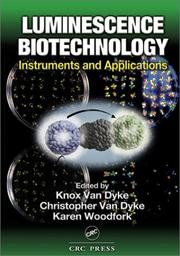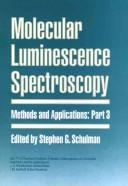| Listing 1 - 10 of 81 | << page >> |
Sort by
|
Book
Year: 1991 Publisher: New York (N.Y.) : Dekker,
Abstract | Keywords | Export | Availability | Bookmark
 Loading...
Loading...Choose an application
- Reference Manager
- EndNote
- RefWorks (Direct export to RefWorks)
Provides information on modern luminescence techniques, beginning with a general introduction to luminescence spectroscopy. Divided into two basic sections, the first dealing with fluorescence and the latter part on chemiluminescence. Topics include immunoassays, the use of chemiluminescence in flow
Book
ISBN: 084121235X Year: 1989 Publisher: Washington, D.C. : American Chemical Society,
Abstract | Keywords | Export | Availability | Bookmark
 Loading...
Loading...Choose an application
- Reference Manager
- EndNote
- RefWorks (Direct export to RefWorks)
Book
ISBN: 9780199588336 Year: 2012 Publisher: Oxford Oxford university press
Abstract | Keywords | Export | Availability | Bookmark
 Loading...
Loading...Choose an application
- Reference Manager
- EndNote
- RefWorks (Direct export to RefWorks)
Luminescence spectroscopy --- Semiconductors --- Optical properties

ISBN: 0849307198 Year: 2002 Publisher: Boca Raton (Fla.) : CRC press,
Abstract | Keywords | Export | Availability | Bookmark
 Loading...
Loading...Choose an application
- Reference Manager
- EndNote
- RefWorks (Direct export to RefWorks)
Luminescence immunoassay. --- Luminescence spectroscopy. --- Luminescent probes.
Book
ISBN: 9780367445935 9781439834671 Year: 2019 Publisher: Boca Raton, FL : CRC Press,
Abstract | Keywords | Export | Availability | Bookmark
 Loading...
Loading...Choose an application
- Reference Manager
- EndNote
- RefWorks (Direct export to RefWorks)
Photoluminescence spectroscopy is an important approach for examining the optical interactions in semiconductors and optical devices with the goal of gaining insight into material properties. With contributions from researchers at the forefront of this field, Handbook of Luminescent Semiconductor Materials explores the use of this technique to study semiconductor materials in a variety of applications, including solid-state lighting, solar energy conversion, optical devices, and biological imaging. After introducing basic semiconductor theory and photoluminescence principles, the book focuses on the optical properties of wide-bandgap semiconductors, such as AlN, GaN, and ZnO. It then presents research on narrow-bandgap semiconductors and solid-state lighting. The book also covers the optical properties of semiconductors in the nanoscale regime, including quantum dots and nanocrystals. This handbook explains how photoluminescence spectroscopy is a powerful and practical analytical tool for revealing the fundamentals of light interaction and, thus, the optical properties of semiconductors. The book shows how luminescent semiconductors are used in lasers, photodiodes, infrared detectors, light-emitting diodes, solid-state lamps, solar energy, and biological imaging.
Luminescence spectroscopy. --- Photoluminescence. --- Semiconductors. --- Spectroscopie de luminescence. --- Semiconducteurs.
Book
ISBN: 084121560X Year: 1989 Volume: vol 383
Abstract | Keywords | Export | Availability | Bookmark
 Loading...
Loading...Choose an application
- Reference Manager
- EndNote
- RefWorks (Direct export to RefWorks)
Luminescence spectroscopy --- Biochemistry --- Environmental chemistry --- Human Anatomy & Physiology --- Health & Biological Sciences --- Animal Biochemistry --- Congresses --- Technique --- Congresses.
Book
ISBN: 0123745861 9786612286919 1282286919 0080923348 Year: 2008 Publisher: San Diego, Calif. ; London : Academic,
Abstract | Keywords | Export | Availability | Bookmark
 Loading...
Loading...Choose an application
- Reference Manager
- EndNote
- RefWorks (Direct export to RefWorks)
Fluorescence spectroscopy is a type of electromagnetic spectroscopy, using a beam of light, which analyzes fluorescence from a sample. Given its extremely high sensitivity and selectivity, it is an important investigational tool in many areas including material sciences, analytical sciences, and across a broad range of chemical, biochemical and medical research. It has become an essential investigational technique allowing detailed, real-time observation of the structure and dynamics of intact biological systems. The pharmaceutical industry uses it heavily and it has become a dominating tec
Book
ISBN: 9535127632 9535127624 9535141538 Year: 2016 Publisher: IntechOpen
Abstract | Keywords | Export | Availability | Bookmark
 Loading...
Loading...Choose an application
- Reference Manager
- EndNote
- RefWorks (Direct export to RefWorks)
The aim of this book is to give readers a broad review of topical worldwide advancements in theoretical and experimental facts, instrumentation and practical applications erudite by luminescent materials and their prospects in dealing with different types of luminescence like photoluminescence, electroluminescence, thermo-luminescence, triboluminescence, bioluminescence design and applications. The additional part of this book deals with the dynamics, rare-earth ions, photon down-/up-converting materials, luminescence dating, lifetime, bioluminescence microscopical perspectives and prospects towards the basic research or for more advanced applications. This book is divided into four main sections: luminescent materials and their associated phenomena; photo-physical properties and their emerging applications; thermoluminescence dating: from theory to applications, and bioluminescence perspectives and prospects. Individual chapters should serve the broad spectrum of common readers of diverse expertise, layman, students and researchers, who may in this book find easily elucidated fundamentals as well as progressive principles of specific subjects associated with these phenomena. This book was created by 14 contributions from experts in different fields of luminescence and technology from over 20 research institutes worldwide.
Luminescence immunoassay. --- Immunoassay --- Luminescence spectroscopy --- Physical Sciences --- Engineering and Technology --- Optical Physics --- Physics --- Optics and Lasers

ISBN: 0471636843 0471868485 Year: 1985 Volume: 77 Publisher: New York Toronto Singapore Wiley
Abstract | Keywords | Export | Availability | Bookmark
 Loading...
Loading...Choose an application
- Reference Manager
- EndNote
- RefWorks (Direct export to RefWorks)
Book
ISBN: 9783038265788 3038265780 3038351954 9783038351955 9783038351955 Year: 2014 Publisher: Switzerland : Switzerland : Trans Tech Publications, Trans Tech Publications,
Abstract | Keywords | Export | Availability | Bookmark
 Loading...
Loading...Choose an application
- Reference Manager
- EndNote
- RefWorks (Direct export to RefWorks)
The word luminescence was first used by a German physicist, Eilhardt Wiedemann, in 1888. He also classified luminescence into six kinds according to the method of excitation. No better basis of classification is available today. He recognized photoluminescence, thermoluminescence, electroluminescence, crystalloluminescence, triboluminescence, and chemiluminescence. The designations are obvious, characterized by the prefix. This Volume consists of 9 Chapters, including 8 Review Papers and one Case Study. The first two papers are based on OLEDs. Organic light emitting diodes (OLEDs) have been th
Luminescence --- Luminescence spectroscopy --- Luminescence spectrometry --- Spectrometry, Luminescence --- Spectroscopy, Luminescence --- Spectrum analysis --- Luminescent probes
| Listing 1 - 10 of 81 | << page >> |
Sort by
|

 Search
Search Feedback
Feedback About UniCat
About UniCat  Help
Help News
News